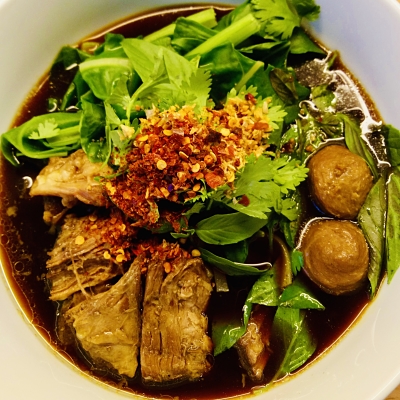BY ADELINE LIM
There is anticipation in the air, as governments in Europe announce the relaxing of border crossings in June, as the grip of the pandemic starts to loosen. Airlines are starting to reschedule their flights for the summer and autumn seasons. The bold and optimistic are starting to plan their holidays again. But long-haul flights to exotic destinations like Asia are still far beyond our grasp.
We can, sometimes, appease our appetite for exotic food by visiting our local Indian, Thai or Vietnamese. And though some lesser known dishes are hard to find even in the best restaurants, we can attempt to recreate them at home.
One such dish is the renowned Thai Boat Noodles, Koay Teow Ruea. In its authentic version, the broth is made with lemongrass, ginger, kaffir lime leaves, pepper, coriander and the most important ingredient – cow’s blood. The touch of blood, known as nam tok broth was used as a natural thickener and imparted an umami flavour. And while cow’s blood is not readily available in the refrigerated section of Rewe or Edeka, I suspect many may not find it palatable as well. An average person would not make the trek to the nearby slaughterhouse for a pail of blood too. “Bye, darling, just popping out for some fresh blood!” – that is a concept that seems preposterous in this day and age.
History of Thai Boat Noodles
Koay Teow Ruea can boast of an origin dating back to the 12th century, when the kingdom of Thailand was ruled from the ancient Ayutthaya. Then, the city was a tangled web of canals, rivers and moats and between the 12th and 16th centuries, the easiest way to get around was by boat. Food vendors found that travelling around by boat peddling their product was efficient. They just paddled up to a bridge, or wherever people congregated by the waterways. They would make the noodles in the boat and serve them to the people who sat by the banks of the canals and rivers. When the capital of Thailand moved south from Ayutthaya to Bangkok, the popularity of the dish flourished there as well.
Boat noodles are traditionally served with chewy rice noodles known as sen yai lek which is just a narrower form of the noodles used in Phad Thai. The portions were always very small, as it was generally a snack rather than a meal. And the small portion, in a generally large bowl, made it easier to manage on a rocking boat.
Koay Teow Ruea has almost disappeared from the Thai waterways. People nowadays prefer to sit in a brick and mortar venue for a meal, and the vendors are mainly concentrated in floating markets. While we are all still held hostage by the pandemic and a trip to Thailand seems an unattainable dream at present, we might still be able to bring a little bit of Thailand into our homes.
Make your own Thai Boat Noodles
A modern and very acceptable form of this dish can be replicated easily and to a delicious result. The main ingredients which make the noodle broth special are coriander root, garlic and black peppercorns which the Thai affectionately call Saamkler (the three buddies).

Generally, German supermarkets sell coriander without the root, but the full herb, roots and all, can be found in Asian or Turkish supermarkets. Once the stock is prepared, one can tweak the dish to suit an individual’s preference, be it vegetarian or not. And if you like your soup spicier, you can use white pepper instead of black pepper or even a mix of both. That is the wonderful thing about Asian cooking, there is no one strict recipe. Everything is flexible.
To bring a little bit of the exotic onto your dining table, try this recipe out!
Serves 4
Ingredients
Saamkler:
6 cloves garlic, peeled
6 coriander roots, cleaned and chopped roughly
1½ tsp whole black peppercorns
* To make the Saamkler pound all these ingredients in a mortar and pestle.
500g “Suppenfleish” / “Rinderrippe” / beef short ribs
3 whole star anise
1 cinnamon stick
¼ cup soy sauce
12 tbsp dark soy sauce
1L water or beef/chicken stock
Large handful of sliced Asian greens such as gai lan (Chinese green kale)
4 portions of noodles (rice or egg noodles)
Thai basil leaves and/or fresh coriander
Fish sauce
Method
- Heat some oil in a pot and add the Saamkler and cook for a few moments until it is fragrant. Add beef and sear until it has a nice caramel colour. Add star anise, cinnamon stick, soy sauces and water and bring to a simmer. Reduce heat to low, cover with a lid and simmer for 1.5 hours or until the beef is fall-apart tender.
- When the beef is tender, transfer to a plate and fork it apart, removing the bone and any unwanted fat. Set aside until ready to serve.
- You can either strain the stock or just remove the dry spices – cinnamon and star anise, with a slotted spoon. Blanch the Asian greens in the soup stock.
- Cook the noodles according to the package instructions and portion them into serving bowls. Top with the beef, Asian greens and ladle over the soup. Top with Thai basil leaves and/or fresh coriander. Season with fish sauce.
Tip: you can make the Saamkler in advance and freeze it.
About the author
Adeline Lim is a serial traveller with an insatiable appetite for good food. She eats almost everything, and is willing to try anything; she loves her beer and wine and everything in between. More about Adeline here.

